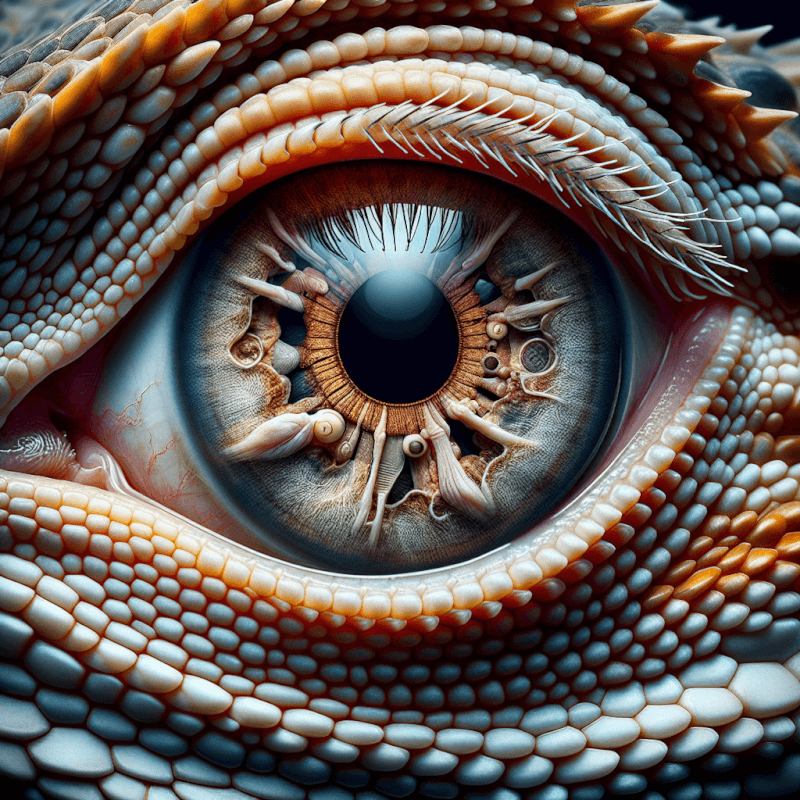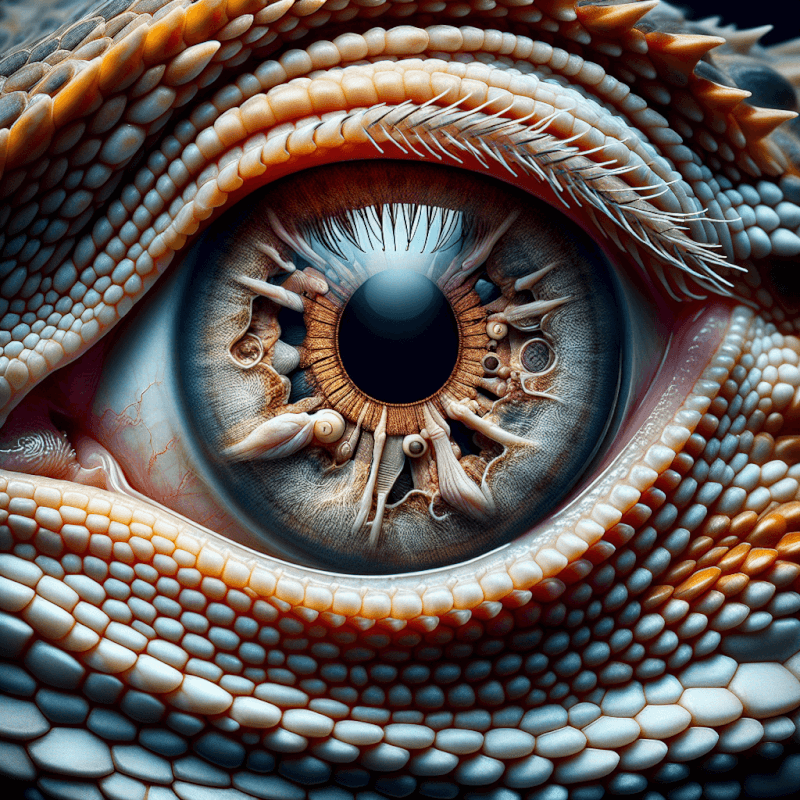If you’re a proud owner of a bearded dragon, you know how important it is to keep them in optimal health. One common issue that can arise is eye problems. These adorable reptiles may encounter a variety of issues, from swelling and redness to discharge and even difficulty opening their eyes. It’s crucial to understand the underlying causes of these eye problems to provide the best care for your scaly friend. In this article, we’ll explore the possible factors behind these eye issues and discover effective solutions to help keep your bearded dragon’s eyes bright, healthy, and beaming with joy.
Common Eye Problems in Bearded Dragons
Bearded dragons are fascinating reptiles that make popular pets due to their unique appearance and docile nature. However, like any other living creature, they can experience various health issues, including eye problems. In this article, we will explore the most common eye problems that bearded dragons may encounter and discuss their causes, symptoms, treatment options, and preventive measures.

Corneal Ulcers
One of the eye problems that bearded dragons may develop is corneal ulcers. Corneal ulcers are open sores that form on the transparent front part of the eye, known as the cornea. These ulcers can be caused by a variety of factors, including trauma to the eye, bacterial or fungal infections, or even excessive dryness.
Symptoms of Corneal Ulcers
If your bearded dragon has a corneal ulcer, you may notice symptoms such as redness, swelling, discharge from the eye, and a cloudy appearance. Your dragon may also squint or keep the eye closed due to the discomfort caused by the ulcer.
Treatment of Corneal Ulcers
Treatment for corneal ulcers in bearded dragons usually involves a combination of topical medications and supportive care. Your veterinarian may prescribe antibiotic or antifungal eye drops to combat any underlying infections. Additionally, lubricating eye drops or ointments can help promote healing and relieve discomfort.
Prevention of Corneal Ulcers
To prevent corneal ulcers in your bearded dragon, it is important to ensure their habitat is free of sharp objects or rough surfaces that could potentially injure their eyes. Regularly inspecting the enclosure and removing any hazards can significantly reduce the risk of corneal ulcers.
Conjunctivitis
Another common eye problem seen in bearded dragons is conjunctivitis. Conjunctivitis, also known as “pink eye,” is an inflammation of the conjunctiva, the thin membrane that covers the inner surface of the eyelids and the white part of the eye.
Causes of Conjunctivitis
Conjunctivitis in bearded dragons can be caused by a bacterial or viral infection, irritants in the environment, or even poor hygiene. Dust, debris, and inadequate cleaning of the enclosure can all contribute to the development of conjunctivitis.
Symptoms of Conjunctivitis
If your bearded dragon is suffering from conjunctivitis, you may observe symptoms such as redness, swelling, watery discharge, and crust formation around the eyes. The affected eye may appear puffy, and your dragon may frequently blink or rub its eye to alleviate the discomfort.
Treatment of Conjunctivitis
Treatment for conjunctivitis typically involves a combination of topical medications and environmental adjustments. Your veterinarian will prescribe antibiotic or antiviral eye drops to combat the infection, while ensuring that the dragon’s habitat is kept clean and free of irritants.
Prevention of Conjunctivitis
To prevent conjunctivitis in your bearded dragon, it is crucial to maintain good hygiene practices. Regularly clean the enclosure, remove any accumulated debris, and ensure that the dragon’s bedding is kept clean and dry. Additionally, avoid exposing your dragon to potential sources of infection, such as other sick reptiles.

Stuck Shed on the Eyes
Bearded dragons, like many reptiles, shed their skin periodically to grow and regenerate. However, there are instances when pieces of shed skin can become stuck around their eyes, leading to irritation and potential eye problems.
Causes of Stuck Shed on the Eyes
Stuck shed on the eyes can occur when the humidity level in the dragon’s habitat is insufficient, causing the shed skin to become dry and adhere to the sensitive skin around the eyes. Inadequate shedding surfaces or injuries to the eyelids can also contribute to this issue.
Symptoms of Stuck Shed on the Eyes
If your bearded dragon has stuck shed on its eyes, you might notice that the skin around the eyes appears dull or discolored. Your dragon may also display signs of irritation, such as rubbing its eyes against objects or repeatedly blinking.
Treatment of Stuck Shed on the Eyes
To address stuck shed on the eyes, it is important to provide your bearded dragon with a suitable shedding environment. This can include a moist hide, where your dragon can seek refuge during shedding periods. Additionally, you can gently assist in removing the stuck shed by using a damp cotton swab or a warm, wet cloth.
Prevention of Stuck Shed on the Eyes
To prevent the occurrence of stuck shed on the eyes, it is crucial to maintain proper humidity levels within the bearded dragon’s enclosure. This can be achieved by regularly misting the enclosure with water or using a reptile-specific humidifier. Providing adequate shedding surfaces, such as smooth rocks or pieces of bark, can also assist in facilitating the shedding process.
Eye Infections
Eye infections are relatively common in bearded dragons and can be caused by a variety of factors, including bacterial, viral, or fungal organisms.
Causes of Eye Infections
Bearded dragons can develop eye infections due to poor husbandry practices, such as unclean environments or inadequate nutrition. Additionally, injuries to the eye or exposure to other infected reptiles can also contribute to the development of eye infections.
Symptoms of Eye Infections
If your bearded dragon is suffering from an eye infection, you may observe symptoms such as redness, swelling, discharge, cloudiness, or even changes in the eye’s size or shape. Your dragon may also display signs of discomfort, such as rubbing its eye or blinking excessively.
Treatment of Eye Infections
Treatment for eye infections in bearded dragons typically involves a combination of topical or systemic medications, depending on the severity of the infection. Your veterinarian may prescribe antibiotic, antiviral, or antifungal medications, along with supportive care measures to alleviate any discomfort or inflammation.
Prevention of Eye Infections
To prevent eye infections in your bearded dragon, it is crucial to maintain a clean and hygienic habitat. Regularly clean the enclosure, remove any feces or uneaten food promptly, and ensure that the dragon’s water is fresh and clean. Moreover, avoid introducing infected or sick reptiles into the same environment as your bearded dragon.

Foreign Bodies in the Eyes
Bearded dragons are naturally curious creatures, and there is always a risk that foreign objects or debris can enter their eyes, leading to irritation or injury.
Causes of Foreign Bodies in the Eyes
Foreign bodies in the eyes can occur when bearded dragons come into contact with dusty or debris-filled environments. Loose substrate in the enclosure, such as wood shavings or sand, can also pose a risk if particles find their way into the eyes.
Symptoms of Foreign Bodies in the Eyes
If your bearded dragon has a foreign body in its eyes, you may observe symptoms such as excessive blinking, redness, tearing, swelling, or discharge. Your dragon may also paw at its eye or display signs of irritability and discomfort.
Treatment of Foreign Bodies in the Eyes
To eliminate foreign bodies from your dragon’s eyes, it is essential to exercise caution and avoid causing further injury. Using a damp cotton swab or a saline solution, gently and carefully try to remove the foreign object without applying excessive pressure. However, if you are unable to remove the object safely, it is best to consult your veterinarian for professional assistance.
Prevention of Foreign Bodies in the Eyes
Preventing foreign bodies in the eyes can be achieved by providing a clean and hazard-free enclosure for your bearded dragon. Avoid using loose substrate, opt for solid flooring or reptile carpet instead. Regularly inspect the environment to remove any potential sources of debris, ensuring that your dragon’s eyes are protected from harm.
Eye Injuries
Eye injuries can occur in bearded dragons as a result of various accidents or situations, and they should be taken seriously.
Causes of Eye Injuries
Bearded dragons may sustain eye injuries due to falls, rough handling, or encounters with sharp objects. Fights with other bearded dragons or attacks from prey animals or predators can also result in eye injuries.
Symptoms of Eye Injuries
Symptoms of eye injuries can vary depending on the severity of the injury. You may observe redness, swelling, discharge, changes in eye shape or size, cloudiness, or even a protruding eye. Your dragon may display signs of discomfort, such as rubbing or avoiding the affected eye.
Treatment of Eye Injuries
Eye injuries in bearded dragons typically require immediate veterinary attention. Depending on the specific injury, treatment may involve medication to prevent infection, lubrication to promote healing, or even surgical intervention in severe cases.
Prevention of Eye Injuries
Preventing eye injuries in bearded dragons requires exercising caution and ensuring they are kept in a safe environment. Provide adequate supervision during handling, avoid placing objects or toys near the dragon’s habitat that could pose a risk, and consider separating bearded dragons that display aggressive behavior towards each other.

Cataracts
Cataracts are a relatively rare but serious eye condition that can affect bearded dragons, causing a loss of vision and potentially leading to other complications.
Causes of Cataracts
Cataracts in bearded dragons can be caused by a variety of factors, including genetic predisposition, poor diet, or improper husbandry practices. Exposure to excessive ultraviolet (UV) light or chronic vitamin A deficiency can also contribute to the development of cataracts.
Symptoms of Cataracts
If your bearded dragon has cataracts, you may notice cloudiness or opacity in one or both of their eyes. As the cataracts progress, your dragon’s vision may become impaired, and they may display signs of difficulty seeing their surroundings.
Treatment of Cataracts
Treating cataracts in bearded dragons is often challenging, and surgical removal may be necessary in severe cases. However, the success rate and availability of such procedures may vary. It is essential to consult with a reptile-experienced veterinarian to explore the best course of action for your dragon.
Prevention of Cataracts
To prevent cataracts in your bearded dragon, it is crucial to provide proper nutrition and maintain appropriate husbandry practices. A balanced and varied diet, including foods rich in vitamin A and other essential nutrients, can help promote ocular health. Additionally, ensuring your dragon receives adequate UV light exposure and avoiding excessive exposure to unfiltered sunlight can be beneficial.
Gut Loading Deficiency
Gut loading deficiency is a condition that can indirectly impact the health of a bearded dragon’s eyes by causing nutritional deficiencies.
Causes of Gut Loading Deficiency
Gut loading refers to the practice of feeding nutrient-rich foods to insects, such as crickets or mealworms, before offering them to your bearded dragon. If the insects are not properly gut-loaded, they may lack essential nutrients, such as vitamin A, that contribute to eye health.
Symptoms of Gut Loading Deficiency
The symptoms of gut loading deficiency may be subtle and can manifest as general signs of malnutrition. Your bearded dragon may display a dull or discolored appearance, exhibit reduced appetite, or demonstrate stunted growth. Ultimately, these deficiencies can impact the overall health of the eyes as well.
Treatment of Gut Loading Deficiency
Treating gut loading deficiency involves improving the nutritional quality of the insects being fed to your bearded dragon. Ensure that the insects are provided with a well-balanced diet, including a variety of fruits, vegetables, and calcium-rich foods. Additionally, adding a reptile-specific vitamin and mineral supplement to the insects’ diet can help address any existing deficiencies.
Prevention of Gut Loading Deficiency
Preventing gut loading deficiency requires careful attention to the nutritional needs of the insects. Consider supplementing their diet with commercial gut load products that are designed to provide the necessary vitamins and minerals for your bearded dragon. Regularly evaluate and adjust the gut-loading process to ensure optimal nutrient content before offering insects to your dragon.

Dietary Issues
Bearded dragons require a well-balanced diet to thrive, and inadequate nutrition can lead to a variety of health problems, including those affecting the eyes.
Causes of Dietary Issues
Dietary issues in bearded dragons can arise from feeding an imbalanced diet lacking essential nutrients, such as vitamin A or calcium. Dependence on a limited variety of foods or offering inappropriate food items can also contribute to dietary issues.
Symptoms of Dietary Issues
Symptoms of dietary issues in bearded dragons can vary depending on the specific nutrient deficiency. General signs of malnutrition may include a dull appearance, weight loss, changes in appetite or digestion, and even skeletal abnormalities. The eyes may display symptoms such as cloudiness or other signs of ocular deterioration.
Treatment of Dietary Issues
Treating dietary issues in bearded dragons involves addressing the underlying nutrient deficiencies through dietary adjustments and supplementation. Consult with a reptile-savvy veterinarian or herpetologist to create an appropriate feeding plan tailored to your dragon’s specific needs. They may recommend adding specific foods or reptile-specific vitamin and mineral supplements to ensure balanced nutrition.
Prevention of Dietary Issues
To prevent dietary issues in your bearded dragon, it is crucial to provide a varied and well-rounded diet that meets their nutritional requirements. This can include a combination of commercially available reptile foods, fresh fruits and vegetables, and appropriately sized, gut-loaded prey insects. Regularly evaluate their diet and make adjustments as needed to ensure optimal health and eye function.
In conclusion, bearded dragons are susceptible to various eye problems, ranging from corneal ulcers to dietary issues. Being aware of these common eye problems, their causes, symptoms, treatment options, and preventive measures is vital for ensuring the well-being of your bearded dragon. By providing a suitable habitat, maintaining good hygiene practices, and offering a balanced diet, you can help minimize the risk of eye problems and promote optimal ocular health in your scaly companion. Remember, if you ever have concerns about your bearded dragon’s eyes or overall health, it is always best to consult with a reptile veterinarian for proper diagnosis and guidance.


